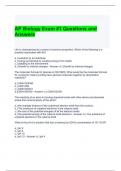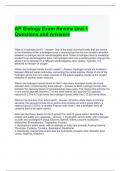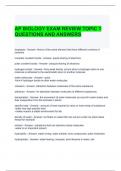Ap biology exam 1 - Study guides, Class notes & Summaries
Looking for the best study guides, study notes and summaries about Ap biology exam 1? On this page you'll find 285 study documents about Ap biology exam 1.
Page 4 out of 285 results
Sort by
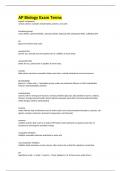
-
AP Biology Exam Terms
- Exam (elaborations) • 23 pages • 2024
-
- $11.59
- + learn more
AP Biology Exam Terms organic compounds contain carbon; examples include lipids, proteins, and carbs functional groups amino (NH2), carbonyl (RCOR), carboxyl (COOH), hydroxyl (OH), phosphate (PO4), sulfhydryl (SH) fat glycerol and three fatty acids saturated fats bad for you; animals and some plants have it; solidifies at room temp. unsaturated fats better for you, plants have it; liquifies at room temp. steriods lipids whose structures resemble chicken-wire fence...
AP Biology Exam #1 Questions and Answers
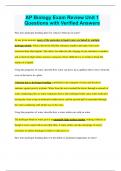
-
AP Biology Exam Review Unit 1 Questions with Verified Answers
- Exam (elaborations) • 15 pages • 2024
- Available in package deal
-
- $9.99
- + learn more
AP Biology Exam Review Unit 1 Questions with Verified Answers How does hydrogen bonding allow for cohesive behavior in water? At any given moment, many of the molecules in liquid water are linked by multiple hydrogen bonds, which collectively hold the substance together and make water more structured than other liquids. This allows for adhesion (the clinging of one substance to another) and a relatively high surface tension (a measure of how difficult it is to stretch or break the surfa...
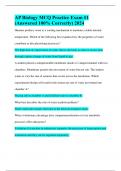
-
AP Biology MCQ Practice Exam #1 (Answered 100% Correctly) 2024
- Exam (elaborations) • 12 pages • 2024
-
Available in package deal
-
- $16.49
- + learn more
AP Biology MCQ Practice Exam #1 (Answered 100% Correctly) 2024 Humans produce sweat as a cooling mechanism to maintain a stable internal temperature. Which of the following best expalins how the properties of water contribute to this physiological process? The high heat of vaporization of water allows the body to remove excess heat through a phase change of water from liquid to gas. A student placed a semipermeable membrane inside a U-shaped channel with two chambers. Membrane permits...
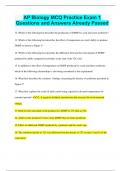
-
AP Biology MCQ Practice Exam 1 Questions and Answers Already Passed
- Exam (elaborations) • 12 pages • 2024
- Available in package deal
-
- $9.99
- + learn more
AP Biology MCQ Practice Exam 1 Questions and Answers Already Passed 12. Which of the follwing best describes the production of DMSP by coral and coral symbionts? 13. Which of the following best describes the effect of temperature on corals' ability to produce DMSP as shown in Figure 1? 14. Which of the following best describes the difference between the total amount of DSMP produced by adults compared to juveniles at the start of the 32C trial. 15. In addition to the effect of temperat...
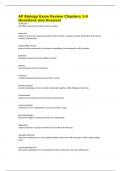
-
AP Biology Exam Review Chapters 1-9 Questions and Answers
- Exam (elaborations) • 8 pages • 2024
- Available in package deal
-
- $10.39
- + learn more
AP Biology Exam Review Chapters 1-9 Questions and Answers prokaryote unicellular organism that doesn't have a nucleus eukaryote organism whose cell contains its genetic material inside a nucleus (includes all life other than viruses, archaea, and bacteria) endosymbiosis theory theory that the eukaryotic cell evolved via engulfing of one prokaryotic cell by another hydrolysis breaking a polymer from the addition of water polymer macromolecule made of monomers monom...
AP Biology Exam Review Unit 1 Questions and Answers
AP BIOLOGY EXAM REVIEW TOPIC 1 QUESTIONS AND ANSWERS
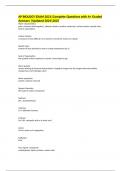
-
AP BIOLOGY EXAM 2021|Complete Questions with A+ Graded Answers |Updated 20242025
- Exam (elaborations) • 28 pages • 2024
- Available in package deal
-
- $10.59
- + learn more
AP BIOLOGY EXAM 2021|Complete Questions with A+ Graded Answers |Updated 20242025 Water characteristics polar, cohesion (hold together), adhesion (hold to another substance), surface tension, specific heat, heat of vaporization Surface Tension A measure of how difficult it is to stretch or break the surface of a liquid Specific Heat amount of heat absorbed or lost to change temperature by 1C Heat of Vaporization the quantity of heat required to convert 1 from liquid to gas ...
![AP Biology [Practice AP Exam] Questions and Answers (Graded A)](/docpics/5221272/663a5298645c3_5221272_121_171.jpeg)
-
AP Biology [Practice AP Exam] Questions and Answers (Graded A)
- Exam (elaborations) • 26 pages • 2024
- Available in package deal
-
- $10.39
- + learn more
AP Biology [Practice AP Exam] Questions and Answers (Graded A) [C] They Include compartments where hydrogen ions are concentrated. [1] Which of the following is true of both mitochondria and chloroplasts? ----------------------------------------------- [A] They are found in the cells of eukaryotic autotrophs and heterotrophs. [B] They include stacks of membranes that absorb light. [C] They Include compartments where hydrogen ions are concentrated. [D] They produce sugars using energ...

$6.50 for your textbook summary multiplied by 100 fellow students... Do the math: that's a lot of money! Don't be a thief of your own wallet and start uploading yours now. Discover all about earning on Stuvia

